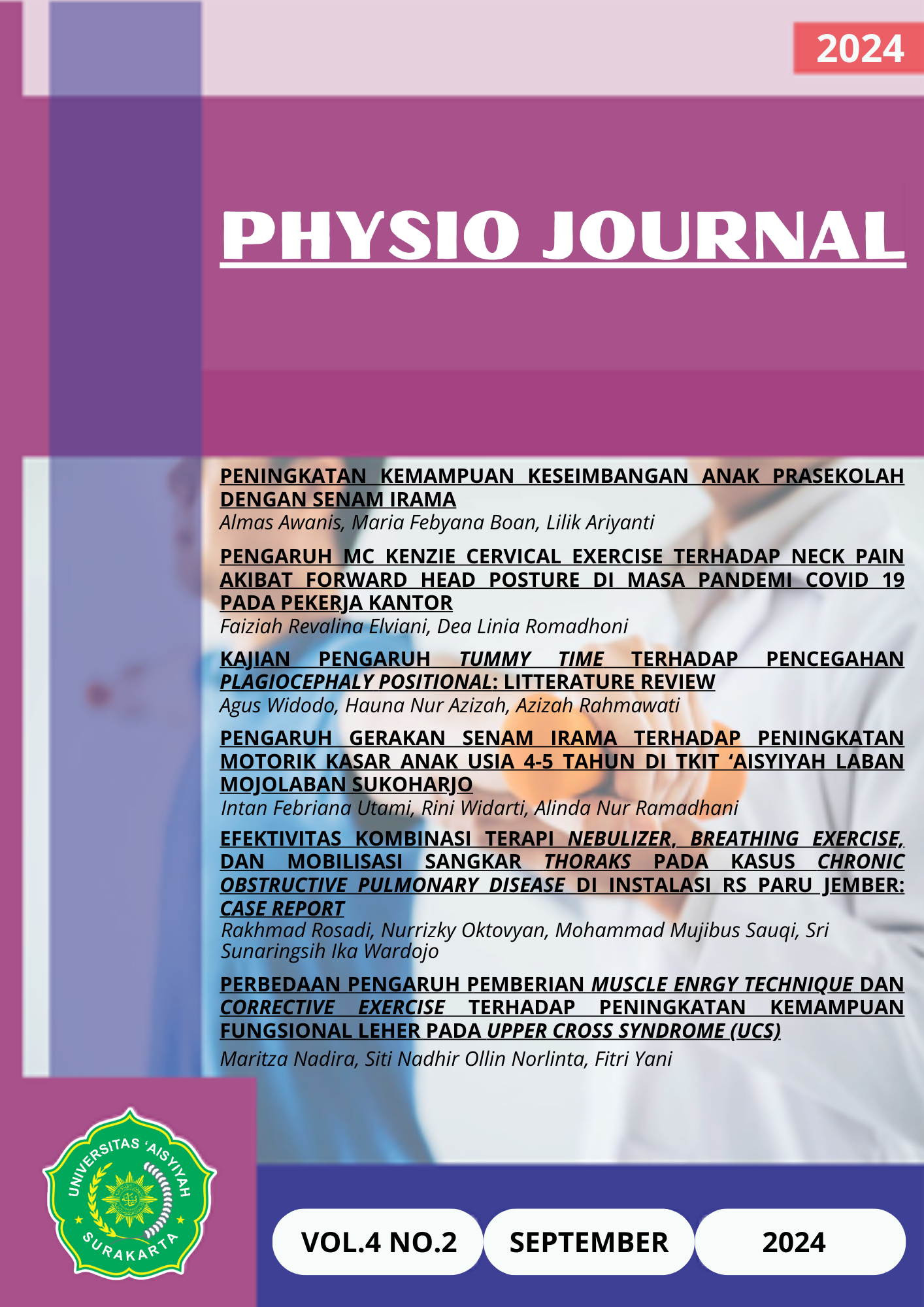KAJIAN PENGARUH TUMMY TIME TERHADAP PENCEGAHAN PLAGIOCEPHALY POSITIONAL: LITTERATURE REVIEW
DOI:
https://doi.org/10.30787/phy.jou.v4i2.1489Keywords:
Tummy time, Plagiocephaly, Flathead, Prone Lying Exersice, ReposisiAbstract
Latar belakang: Plagiocephaly adalah deformitas kepala bayi yang rata atau flat. Faktor risiko yang mempengaruhi terjadinya plagiocephaly positional antara lain posisi tidur bayi, proses persalinan dengan bantuan alat, ibu melahirkan untuk pertama kali, kehamilan ganda atau kembar, cidera sejak lahir, premature, dan anak laki-laki. Tummy time adalah latihan dengan menempatkan bayi pada posisi tengkurap selama beberapa menit. Tujuan: Penelitian ini bertujuan untuk mengetahui pengaruh Tummy time terhadap pencegahan plagiocephaly positional. Metod: Menggunakan metode literatur review. Literatur review merupakan penelusuran atau penelitian berbagai literatur berupa buku, jurnal, maupun sumber lain lain yang berhubungan dengan topik yang akan dibahas. Hasil: Berdasarkan litteratur review yang telah dilakukan ditemukan bahwa Tummy time memiliki pengaruh untuk pencegahan maupun terapi konservatif dari plagiocephaly positional. Kesimpulan: Tummy time dapat dilakukan sesuai dengan usia bayi dimulai dari usia 1 bulan. Durasi waktu dapat disesuaikan dengan kemampuan dan kenyamanan bayi. Untuk mengantisipasi dari adanya kegagalan perbaikan plagiocephaly positional dengan Tummy time dapat didukung dengan intevensi lain yaitu terapi fisik dan terapi helm.
References
Aarnivala, H. et al. (2015) ‘Preventing deformational plagiocephaly through parent guidance: a randomized, controlled trial’, European Journal of Pediatrics, 174(9), pp. 1197–1208. doi:10.1007/s00431-015-2520-x.
Chen, R., & Zhou, J. (2019) ‘Trends in the Decline in Gait and Motor Ability of Older Adults: A Case Study Based on SHARE Data. In Lecture Notes in Computer Science (including subseries Lecture Notes in Artificial Intelligence and Lecture Notes in Bioinformatics)’, Vol. 11593.
Hewitt, L. et al. (2019) ‘Objective measurement of tummy time in infants (0-6 months): A validation study’, PLoS ONE, 14(2), pp. 1–13. doi:10.1371/journal.pone.0210977.
Hewitt, L. et al. (2020) ‘Weekly group tummy time classes are feasible and acceptable to mothers with infants: a pilot cluster randomized controlled trial’, Pilot and Feasibility Studies, 6(1), pp. 1–11. doi:10.1186/s40814-020-00695-x.
Inchingolo, A.D. et al. (2022) ‘A Systematic Review of Positional Plagiocephaly Prevention Methods for Patients in Development’, Applied Sciences (Switzerland), 12(21). doi:10.3390/app122111172.
Jung, B.K. and Yun, I.S. (2020) ‘Diagnosis and treatment of positional plagiocephaly’, Archives of Craniofacial Surgery, 21(2), pp. 80–86. doi:10.7181/acfs.2020.00059.
Koleva M, D.J.O.H. (2023) Pulau Harta Karun (FL). StatPearls.
Noto, T. et al. (2021) ‘Natural-course evaluation of infants with positional severe plagiocephaly using a three-dimensional scanner in japan: Comparison with those who received cranial helmet therapy’, Journal of Clinical Medicine, 10(16), pp. 0–11. doi:10.3390/jcm10163531.
Ramadhania, N., & Sriwenda, D. (2022). PENGARUH TUMMY TIME EXERCISE TERHADAP KEMAMPUAN MOTORIK PADA BAYI: EVIDENCE BASED CASE REPORT (EBCR). Jurnal Kesehatan Siliwangi, 3(1), 36-44.
Ramdani, N., Yulianti, A. and Yuliadarwati, N.M. (2022) ‘Literature Review: Hubungan Posisi Tidur Terhadap Risiko Kejadian Plagiocephaly pada Bayi’, Jurnal Penelitian Inovatif, 2(3), pp. 461–468. doi:10.54082/jupin.103.
Renz-Polster, H. and De Bock, F. (2018) ‘Deformational plagiocephaly The case for an evolutionary mismatch’, Evolution, Medicine and Public Health, 2018(1), pp. 180–185. doi:10.1093/emph/eoy019.
Steinberg, J.P. et al. (2015) ‘Effectiveness of conservative therapy and helmet therapy for positional cranial deformation’, Plastic and Reconstructive Surgery, 135(3), pp. 833–842. doi:10.1097/PRS.0000000000000955.
Tecklin, S.J. (2015) Pediatric Physical Therapy. Edited by E. Lupash.
Van Vlimmeren, L.A. et al. (2017) ‘The course of skull deformation from birth to 5 years of age: a prospective cohort study’, European Journal of Pediatrics, 176(1), pp. 11–21. doi:10.1007/s00431-016-2800-0.
Widodo, A., Rizky, R. and Waspada, E. (2018) ‘Pengaruh Pemberian Tummy Time Exercise Terhadap Peningkatan Kemampuan Gross Motoric Head Control and Rolling Pada Anak …’, Proceeding of The URECOL, pp. 11–15. Available at: http://repository.urecol.org/index.php/proceeding/article/view/291.
Williams, E.N. and Galea, M.P. (2016) ‘Exploring infant deformational or positional plagiocephaly prevention and management by Maternal Child Health Nurses and paediatric physiotherapists’, Australian Journal of Advanced Nursing, 34(2), pp. 53–62. doi:10.37464/2017.342.1519.
Wittmeier, K. and Mulder, K. (2017) ‘Time to revisit tummy time: A commentary on plagiocephaly and development’, Paediatrics and Child Health (Canada), 22(3), pp. 159–161. doi:10.1093/pch/pxx046.
Downloads
Published
Issue
Section
License
Copyright (c) 2024 Physio Journal

This work is licensed under a Creative Commons Attribution-ShareAlike 4.0 International License.

This work is licensed under a Creative Commons Attribution-ShareAlike 4.0 International License.









